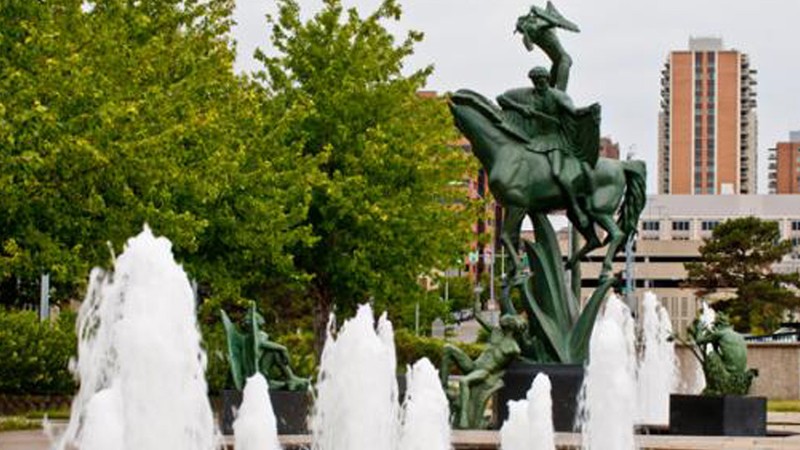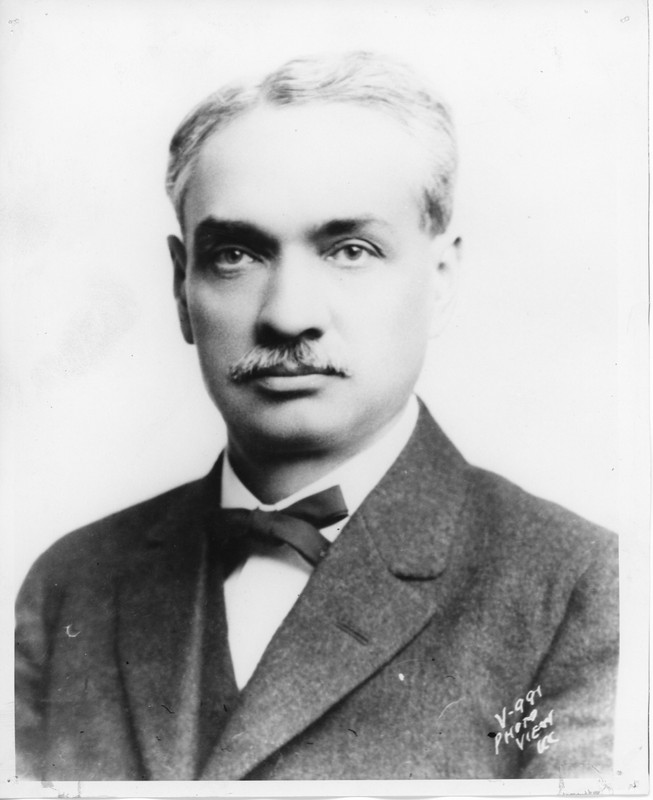William Volker Memorial Fountain
Introduction
Text-to-speech Audio
Swedish sculptor Carl Milles designed this statue and fountain in 1955 to honor William Volker, an entrepreneur known for anonymous gifts to people in need along with leadership and generous financial support of civic projects which included the creation of the University of Missouri-Kansas City, building the city's Research Hospital, Liberty Memorial. The centerpiece of the sculpture is St. Martin of Tours, a young Roman soldier who converted to Christianity and went on to become the patron saint of soldiers. During his life, Volker was known as "Mr. Annonymous" for making thousands of small and confidential donations to citizens in need while also providing seed money to numerous charitable projects around the city. To represent Volker's generosity, the central figure in the fountain is giving away his coat. In the 1990s, the sculpture was moved to this location from Frank A. Theis Park south of the Nelson-Atkins Museum of Art , where it had been originally dedicated in 1958. The road next to the fountain was known as Volker Boulevard until the name was changed to honor civil rights leader Martin Luther King, Jr., decision city leaders recognized would have surely met the approval of Volker given his preference for anonymity and support of diverse institutions and people throughout his life.
Images
William Volker Memorial Fountain

Portrait of William Volker from the Kansas City Public Library courtesy of the Kansas City Museum

Backstory and Context
Text-to-speech Audio
Born in Germany, William Volker moved with his family in 1871 to the United States at the onset of the war between France and Prussia, partially in hopes of protecting the twelve-year-old William from compulsory military service should the war continue. The family arrived in Chicago just days after the Great Fire. In 1876, While only seventeen years old, Volker took a job with a picture frame manufacturer. In 1882, while in his early 20s, Volker moved to Kansas City and used his small life savings as seed money to create the William Volker & Company, a picture frame wholesaler. The company added home furnishings sales, expanded to branch offices in numerous large Western cities, and ultimately evolved into a multi-million dollar business.
Volker used his millions and influence to become a thriving philanthropist and leader of social welfare. In an era known for great fortunes, Volker used his wealth and influence to spearhead the creation of the Board of Public Welfare in Kansas City. When the City Council approved the Board in 1910, it became the first nation's first modern welfare department. In an era of segregation, Volker supported African American community institutions such as hospitals and educational institutions, and he also created the city's research hospital.
Volker believed that a great city deserved and needed a great university, and he took the lead in creating the then-private University of Kansas City (now the University of Missouri-Kansas City, or UMKC). Volker also led the creation of the Civic Research Institute, and purchased land for the Liberty Memorial. During his life, Volker was best known for donating money to those in need and it was common knowledge that one could call on Mr. Volker at his office or home to make a personal request if one needed help. Although his reputation for generosity spread throughout the city, Volker gained the nickname "Mr. Anonymous" because he asked that his benefactors keep his philanthropy private. Volker routinely donated large sums of money anonymously and was equally consistent in requesting that the parks, memorials, and institutions he helped create not include his name.
St. Martin lived roughly around C.E 316 to C.E. 397, serving as a Roman Soldier in his younger days until a meeting with a shivering beggar led to his conversion into a Christian. Legend has it that upon seeing the beggar freezing, Martin cut his cloak in half and gave half to the cold beggar. And, the legend continues, he went to bed that night and dreamt that the beggar was Jesus Christ; the meeting and dream led to his Christian conversion. Although he initially remained a soldier, choosing to spread the Christian Gospel while still remaining loyal to Ceaser, he eventually resigned (341 C.E.) from the army. Martin eventually became Bishop of Tours in France. Martin now enjoys recognition as the patron saint of soldiers, beggars, and the nation of France, celebrated formally on Armistice Day, November 11.
St. Martin is depicted in the sculpture as a young Roman soldier cutting his cloak to share with the frozen beggar while two angels witness the encounter. The memorial was dedicated in 1958, three years after the death of sculptor Carl Milles. The fountain is currently located south of Brush Creek, but there have been plans to move the fountain back to its original location north of the creek to give it greater visibility in the green space across from the Nelson-Atkins Museum of Art. That space was part of William Rockhill Nelson's vast estate and is now home to Frank A. Theis Park.
Sources
Coleman, Daniel. "William Volker: Businessman and Philanthropist, 1859-1947." The Kansas City Public Library. kchistory.org. Accessed August 4, 2022. https://kchistory.org/document/biography-william-volker-1859-1947-businessman-and-philanthropist.
Klem, Monica. "William Volker." Philanthropic Roundtable. 2022. https://www.philanthropyroundtable.org/resource/william-volker/.
Roe, Jason. "William Volker." Kansas City Public Library: Pendergrast Years. Accessed August 5, 2022. https://pendergastkc.org/article/biography/william-volker.
Kosloski, Phillip. "How St. Martin became a soldier of Christ." Aleteia. aleteia.org. November 11, 2022. https://aleteia.org/2020/11/11/how-st-martin-became-a-soldier-of-christ/.
Virginia Commonwealth University Library. "Volker, William." Social Welfare Project. vcu.edu. Accessed August 2, 2022. https://socialwelfare.library.vcu.edu/people/volker-william/.
"William Volker Memorial Fountain." City of Fountains Foundation. Accessed August 1, 2022. https://cityoffountains.org/william-volker-memorial-fountain/.
City of Fountains Foundation: https://cityoffountains.org/william-volker-memorial-fountain/
Kansas City Museum (George Fuller Green Collection).
